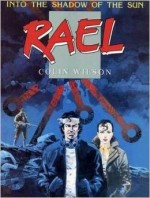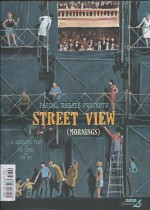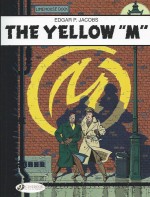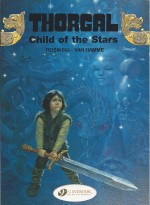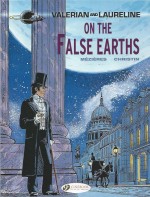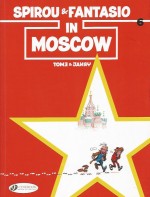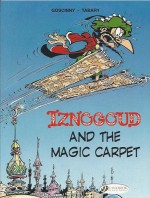
By Tove and Lars Jansson (Drawn & Quarterly)
ISBN: 978-1-89729-994-4
Win’s Christmas Gift Recommendation: Moomins Aren’t Just For Christmas, But For Life… 10/10
Tove Jansson was one of the greatest literary innovators and narrative pioneers of the 20th century: equally adept at shaping words and images to create worlds of wonder. She was especially expressive with basic components such as pen and ink, manipulating slim economical lines and patterns to realise sublime realms of fascination, whilst her dexterity made simple forms into incredibly expressive and potent symbols.
Tove Marika Jansson was born into an artistic, intellectual and practically bohemian Swedish family in Helsinki, Finland on August 9th 1914. Her father Viktor was a sculptor, her mother Signe Hammarsten-Jansson a successful illustrator, graphic designer and commercial artist. Tove’s brothers Lars and Per Olov became a cartoonist/writer and photographer respectively. The family and its close intellectual, eccentric circle of friends seems to have been cast rather than born, with a witty play or challenging sitcom as the piece they were all destined to act in.
After intensive study from 1930-1938 (University College of Arts, Crafts and Design, Stockholm, the Graphic School of the Finnish Academy of Fine Arts and L’Ecole d’Adrien Holy and L’Ecole des Beaux-Arts, Paris) she became a successful exhibiting artist through the troubled period of the Second World War. Intensely creative in many fields, she published the first fantastic Moomins adventure in 1945: SmÃ¥trollen och den stora översvämningen (The Little Trolls and the Great Flood or latterly and more euphoniously The Moomins and the Great Flood), a whimsical epic of gentle, inclusive, accepting, understanding, bohemian, misfit trolls and their strange friends…
A youthful over-achiever, from 1930-1953 Tove worked as an illustrator and cartoonist for the Swedish satirical magazine Garm, and achieved some measure of notoriety with an infamous political sketch of Hitler in nappies that lampooned the Appeasement policies of Chamberlain and other European leaders in the build-up to World War II. She was also an in-demand illustrator for many magazines and children’s books, and had started selling comic strips as early as 1929.
Moomintroll was her signature character. Literally.
The lumpy, gently adventurous big-eyed romantic goof began life as a spindly sigil next to her name in her political works. She called him “Snork†and claimed she had designed him in a fit of pique as a child – the ugliest thing a precocious little girl could imagine – as a response to losing an argument about Immanuel Kant with her brother.
The term “Moomin†came from her maternal uncle Einar Hammarsten who attempted to stop her pilfering food when she visited by warning her that a Moomintroll guarded the kitchen, creeping up on trespassers and breathing cold air down their necks. Snork/Moomin filled out, became timidly nicer – if a little clingy and insecure – acting as a placid therapy-tool to counteract the grimness of the post-war world.
The Moomins and the Great Flood didn’t make much of an initial impact but Jansson persisted, probably as much for her own edification as any other reason, and in 1946 the second book Kometjakten (Comet in Moominland) was published. Many commentators have reckoned the terrifying tale a skilfully compelling allegory of Nuclear Armageddon.
When it and her third illustrated novel Trollkarlens hatt (1948, Finn Family Moomintroll or occasionally The Happy Moomins) were translated into English in 1952 to great acclaim, it prompted British publishing giant Associated Press to commission a newspaper strip about her seductively sweet and sensibly surreal creations.
Jansson had no misgivings or prejudices about strip cartoons and had already adapted Comet in Moominland for Swedish/Finnish paper Ny Tid.
Mumintrollet och jordens undergäng – Moomintrolls and the End of the World – was a popular feature so Jansson readily accepted the chance to extend her eclectic family across the world.
In 1953 The London Evening News began the first of 21 Moomin strip sagas which promptly captivated readers of all ages. Tove’s involvement in the cartoon feature ended in 1959, a casualty of its own success and a punishing publication schedule. So great was the strain that towards the end she had recruited her brother Lars to help. He took over, continuing the feature until its end in 1975. The three strips in this volume were all scripted by Lars and illustrated by his sister.
Free of the strip, Tove returned to painting, writing and her other creative pursuits, generating plays, murals, public art, stage designs, costumes for dramas and ballets, a Moomin opera and another nine Moomin-related picture-books and novels, as well as thirteen books and short-story collections strictly for grown-ups.
Tove Jansson died on June 27th 2001 and her awards are too numerous to mention, but consider this: how many modern artists – let alone comics creators – get their faces on the national currency?
Her Moomin comic strips have long been available in Scandinavian volumes and the discerning folk at Drawn & Quarterly have translated these into English for your – and especially my – sheer delight and delectation.
Moomintrolls are easygoing free spirits, bohemians untroubled by hidebound domestic mores and societal pressures. Moominmama is warm and capable but overly concerned with propriety and appearances whilst Moominpappa spends most of his time trying to rekindle his adventurous youth or dreaming of fantastic journeys. Their son Moomin is a meek and dreamy boy who adores their permanent guest Snorkmaiden – although that impressionable gamin prefers to play things slowly whilst waiting for somebody potentially better…
This fifth oversized (312 x 222mm) monochrome hardback compilation gathers the 19th, 20th and 21st strip sagas and is a particular favourite, comprising a trio of epic length sequences commencing with ‘Moomin Winter’ as the worst snow season in living memory begins and the nonconformist family decide that this year they will return to traditional ways and hibernate as proper Moomintrolls should…
However happenstance and their own magnanimous natures work against them as other locals – less prepared for the winter’s icy blasts – keep turning up seeking succour, solace and shelter. Naturally no decent creature could turn away neighbours – or even complete strangers – in need…
First it’s timid Miss Fluffins nervously tapping on the door then a little later the quirkily obnoxious Gromf imposing himself upon them, but the truly disruptive influence only arrives after a most odd Christmas when the snow lies metres deep around the house. Delivered through an upstairs window by the indefatigable parcel post is a box containing a baby Nibling…
Abandoning all hope of a successful hibernation, the Moomins become unwilling but polite hosts to them all although, as Niblings are such legendary troublemakers, it’s understandable that Moominmama first goes on a heroic expedition to all the neighbours, striving to find a suitable home (i.e. somebody else’s) for the little mite…
She even briefly considers the draconian local orphanage before relenting and returning home with the nosy, chaos-causing little critter…
As well as having voracious eating habits, the Nibling is less than welcome for its incessant curiosity and stunningly forthright rudeness. As the snowbound days pass the inquisitive meddler sniffs out every shameful secret of the household from Fluffins’ strangely masculine habits to Snorkmaiden’s binge eating, young Moomintroll’s aspirations to thespianism or the fearsome Gromf’s addiction to knitting doilies…
These secrets and others it uses to virtually run the house. Moominpapa retires to his study to reminisce and read the papers whilst his long-suffering wife resorts to the thankless tasks of housework to keep busy. Eventually however, as the months go by the Moomins decide it’s time for drastic action and try to starve all their increasingly unwelcome guests out…
Sadly, as ever, the hosts are too gracious and well-mannered to persist for long and soon the boy troll and incessant Nibling are skiing through the winter wilderness hunting grizzly and moose for the larder. A little later, things come to a comical head when the assemblage decides to share all their secret peccadilloes thus depriving the mischievous Nibling of its power…
This comedy of manners is followed by a boisterously sedate and surreal adventure as ‘Moomin Under Sail’ finds Moominpapa and family joining neighbour Too-Tikki (the eminently practical and capable lady was based on Jansson’s life partner, graphic artist Tuulikki Pietilä, and first appeared in the novel Moominland Midwinter) in building a wooden sailing ship and going voyaging…
The construction is well underway, with everyone contributing in their own unique way, when a wandering poet appears and names the vessel “Mermaid†– which rash Moomin misspells as “Murmade†when painting the hull – before moving on, and all too soon the travellers are underway…
At least they would be if they hadn’t built their boat on a hill and now can’t shift it. Fortunately Too-Tikki knows a rather irascible but polite giant Booble named Mr. Edward who she can convince to move the river for them…
And in a roar of waters they are off, hurtling out to sea in search of wonder, mystery and romance. It comes all too soon as food and whisky starts to vanish and – at least for the ever-imaginative Snorkmaiden – passion is found when the terrified shipmates discover that the beguiling, advantage-taking poet has stowed away…
Young Moomin is less than sanguine that his one and only has become besotted with the unscrupulous scribbler and is secretly delighted when a school of seagoing wild Niblings board the vessel and eat all his odes…
None too soon they depart, taking the poet with them whilst leaving one of their cubs behind. The rapacious tyke is rather sweet but has a disturbing taste for paper and leather goods…
Things begin to go further awry as the babe eats all the charts so Too-Tikki captures some clouds for the child to chew, accidentally precipitating a colossal hurricane which rips their sails away. Happily the clouds make a suitable substitute. There’s even some left to give to Mr. Edward when the aggrieved Booble suddenly shows up…
Sighting land the Moomins and Co go ashore to re-supply and hear worrying stories of a pirate marauder dubbed the “Bloody Mary†before heading back out to sea and encountering a Marie Celeste-like conundrum and inevitable encountering the dread privateers.
Imagine the surprise of the Murmade mariners when they discover the wild freebooters are in fact old acquaintances…
This amazing, enchanting collection concludes with a salutary tale of unrequited love as Moomin makes a new friend and becomes involved with ‘Fuddler’s Courtship’. The meek and rather scruffy young man is a collector of many things – but most especially buttons – and reveals to his new chum that he is hopelessly in love with quirky, overly romantic and lonely Mymble…
Despite their misgivings over the clear mismatch, Moomin and Snorkmaiden attempt to facilitate affairs but the target of the Fuddler’s affections is currently enamoured of a dynamic strongman. Although she’s prepared to give any new suitor a chance, his clumsiness, diffidence, messiness and collecting habits soon drive Mymble back to her photos of the oblivious Sebastian…
With his confidence crushed Fuddler retreats to his coffee-can home to be depressed, provoking Moomin and Snorkmaiden to call in newspaper psychiatrist Dr. Hatter. It is a terrible mistake…
The Shrink is a mass of complexes and neuroses and soon he has infected almost everybody with one of his problems. Moreover Mymble finds the tortured “genius†utterly fascinating.
Moomin then tries everything – even a helpful ghost – to drive Hatter away, but only succeeds in having his entire family locked up. Happily the Fuddler has a collection of keys and other cage-opening gimmicks amongst his copious possessions…
The course of true love continues to run anything but smoothly for all concerned until one night the Fuddler meets a sweet, confused and messily charming collector of shells and stones. Her name is The Jumble…
Wrapping up the Wild Things wonderment is the short essay ‘Tove Jansson: To Live in Peace, Plant Potatoes, and Dream’: a comprehensive biography and commentary by Alisia Grace Chase (PhD) which celebrates the incredible achievements of this genteel giant of literature.
These are truly magical tales for the young laced with the devastating observation and razor sharp mature wit which enhances and elevates only the greatest kid’s stories into classics of literature. These volumes are an international treasure and no fan of the medium – or carbon-based lifeform with even a hint of heart and soul – can afford to be without them.
© 2010, 2014 Solo/Bulls. All other material © its creators. All rights reserved.
